Ornithischia: Stegosauridae
Taxa on This Page
- Chialingosaurus X
- Chungkingosaurus X
- Dacentrurus X
- Kentrosaurinae X
- Kentrosaurus X
- Lexovisaurus X
- Stegosauridae X
- Stegosaurinae X
- Stegosaurus X
- Wuerhosaurus X
Stegosaurus: Blushing Beauty or Jurassic Smart-Ass?
Stegosaurid thermoregulation
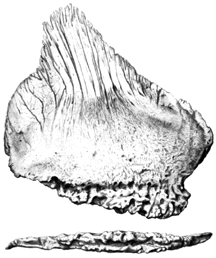 The photograph shows the side and top-bottom view of the large plates on the back of the Stegosaurus. Originally thought to have been a form of armour-plating, the plates of advanced stegosaurs were, as can be seen here, actually quite thin and full of holes for the accomodation of blood vessels. For all large animals heat disipation is a big problem (that is why African elephants have such large ears for example), and the stegosaur plates clearly served this purpose. The plates tend to be small and poorly developed (or even absent) in primitive stegosaurids, but more developed in more advanced forms, indicating that they conferred an adaptive advantage. The advantage may have been related to thermoregulation.
The photograph shows the side and top-bottom view of the large plates on the back of the Stegosaurus. Originally thought to have been a form of armour-plating, the plates of advanced stegosaurs were, as can be seen here, actually quite thin and full of holes for the accomodation of blood vessels. For all large animals heat disipation is a big problem (that is why African elephants have such large ears for example), and the stegosaur plates clearly served this purpose. The plates tend to be small and poorly developed (or even absent) in primitive stegosaurids, but more developed in more advanced forms, indicating that they conferred an adaptive advantage. The advantage may have been related to thermoregulation.
Alternatively, it may have related to sexual selection. That is, the plates may have primarily served a display function. Ankylosaurs, after all were equally big and hot and got along perfectly well without an on-board air conditioner of this kind. It may be more logical to assume that the function of the plates was simply to advertise one's sex, species and physical condition: more like an elephant's tusks than an elephant's ears.
One interesting speculation is that Stegosaurus blushed. That is, that these animals may have combined thermoregulation and display by forcing blood into the plates to change their color, depending on sex and season.
Stegosaurid brains
 |
| This figure shows the Kentrosaurus brain (a) next to the much larger pelvic nerve ganglion (b). |
Stegosaurids had small brains by Dinosaurian standards, although not so small as to fall below the average range of reptilian brain to body weight ratio (the dim-witted dinosaur - all brawn and no brain is in fact a myth). Stegosaurus is famous for its "second brain" - actually an enlarged pelvic nerve plexus situated in the hip region. In fact all dinosaurs and birds and many other sauropsids have such organs (so do mammals, but not developed to such an extent). (MAK990724 & ATW020419)
Descriptions
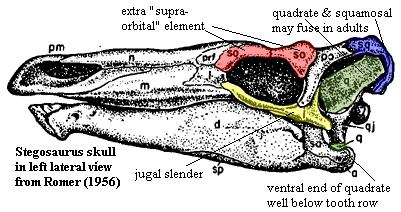 Stegosauridae:
Stegosauridae:
Range: Middle Jurassic to Late? Cretaceous of Eur, NAm, Afr, & China.
Phylogeny: Stegosauria: Huayangosauridae + * : Dacentrurus + Kentrosaurinae.
Characters: skull: wedge-shaped skull [R56]; skull shallower & narrower than huayangosaurids [G97]; rostrum longer than in Huayangosaurids [G90] [SD92] [G97]; horn beak larger than huayangosaurids [G97]; premaxilla dorsal process long & thin [G90]; external nares relatively large [G90]; neomorphic "supraorbital" directly dorsal to orbits [R56]; jugal slender [R56]; quadrate dorsal head broadly contacts squamosal & paroccipital process [G90]; quadrate dorsal end may be fused to squamosal in adults [G97]; quadrate ventral end well below tooth row [R56]; quadrate mandibular condyle faces lateroventrally [G90]; occiput fairly narrow and solid [R56]; supraoccipital angled ~55° from vertical [G90]; paroccipital processes largely formed by opisthotic [G90]; vomers long, extending to end of tooth row [G90]; prootics extensively sutured with basisphenoid & contribute most of posterior floor of braincase [G90]; lagena moderately well developed [G90]; exoccipitals form much of posterior braincase walls [G90]; basisphenoid basioccipital process short & directed anteroventrally [G90]; sides of sella turcica ossified [G90]; orbitosphenoids present, thin, meet to floor olfactory tract [G90]; laterosphenoids present, short & thick [G90]; external mandibular fenestra larger than in huayangosaurids [G90]; premaxilla toothless [G97]; diastema present after predentary [G97]; maxilla with ~25 teeth or less, dentary with <23 [G90]; maxillary tooth row ends anterior to orbit [G90]; axial:vertebral count (Stegosaurus) 10, 16, 5, ~45 [G90]; rib heads remain distinct on all vertebrae [R56]; dorsal ribs fused to diapophyses to form almost solid dorsal plate up to sternum [G97]; caudal neural spines (see image at Stegosauria) tall, expanded & rugose distally [R56]; caudal neural spines "somewhat bifurcate at midlength" presumably associated with armor articulation) [R56]; appendicular: scapula short, with thickened edge which "turns shrply forward well above the coracoid suture" [R56]; prominent acromial process [G90]; coracoid taller than wide [G90]; ilium anterior process angles laterally 40°-50° [G90]; ischial peduncle small & flat [G90]; antitrochanter large [G90]; length of prepubic process increased [G97]; femur lengthened to >145% (from 100% in huayangosaurids) length of humerus [G90] [G97]; femur with 4th trochanter reduced [R56]; poorly developed cnemial crest [R56]; tibia & fibula bow outward away from each other [R56]; astragalus (reduced) and calcaneum may fuse with with tibia and/or fibula [R56]; integument:flank osteoderms absent [G97].
Links: DinoData: Stegosauridae; Ornithischian Dinosaurs - Enchanted Learning Software; stegosauridae.htm Spanish); Stegosaurids; Ornithischia.
References: Galton (1990) [G90]; Galton (1997) [G97], Romer 1956) [R56].
Note: [1] Stegosaurus and Kentrosaurus are sometimes referred to separate eponymous families within Stegosauria, differentiated by the absence and presence (respectively) of spines on the back. [2] Some of the descriptive material from Romer (1956: 633-34) has been incorporated on the assumption that his Stegosaurinae is equivalent to Stegosauridae. However, he was more concerned with distinguishing Stegosaurus and Kentrosaurus from Scelidosaurus than from Huayangosaurus, which was unknown at that time. 011201.
 |
| Dacentrurus armatus Lucas, 1902b |
Dacentrurus:
Range: Late Jurassic of Europe
Phylogeny: Stegosauridae : Kentrosaurinae + *.
Dacentrurus armatus (= Omosaurus armatus Owen, 1875)
Horizon: Lower Kimmeridge Clay of England, Argiles d'Octeville of France, unnamed unit of Portugal
Age: Oxfordian / early Kimmeridgian-late early Tithonian
Place: European islands - middle Laurasia
Remains: two skeletons and assorted postcrania
Length: 7 to 10 meters
Weight: upto 6 tonnes
Comments: This is the first stegosaur described by science, although the original name, Omosaurus, had to be changed to Dacentrurus, (as it was already applied to another animal). It is the most primitive known stegosaurid, with primitive vertebrae and long forelimbs, and some researchers have suggested it deserves to be put in a separate family. It is also among the largest of the stegosaurs. There are also a number of specilised features in the vertebrae and hip that prevent from being an actual ancestor. As with many early-named European dinosaurs, the species seems to be something of a garbage taxon for fragmentary remains of a generally similiar type, as it is unlikely that one species would persist for a period of some 10 or 12 million years or so. Some remains suggest individuals of 10 meters in length, larger than the biggest Stegosaurus. MAK990724.
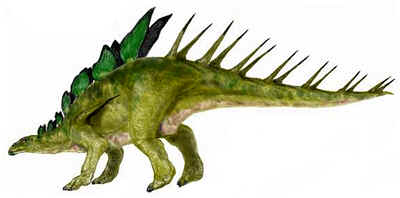 Kentrosaurinae: Craterosaurus?
Kentrosaurinae: Craterosaurus?
Range: Middle Jurassic to Late? Cretaceous
Phylogeny: Stegosauridae : Dacentrurus + * : Kentrosaurus + (Chialingosaurus + (Chungkingosaurus) + Stegosaurinae))
Comments: These are relatively basal stegosaurids, small to large in size, with generally small spiked plates and numerous spikes along the tail, and sometimes the hips and shoulders as well. A paraphyletic group, they are transitional between the Dacentrurines and the Stegosaurines. MAK990724; ATW031018.
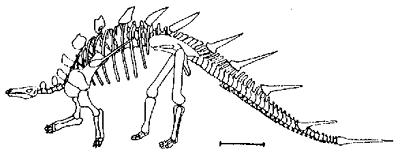 Kentrosaurus:
Kentrosaurus:
Range: Late Jurassic Kimmeridgian) of Africa
Phylogeny: Kentrosaurinae : (Chialingosaurus + (Chungkingosaurus + Stegosaurinae)) + *.
Kentrosaurus aethiopicus Hennig, 1915
Horizon: Tendaguru formation, Tanzania
Age: middle to late Kimmeridgian
Place: central Gondwana
Remains: remains of several individuals
Length: 2.5 to 5 meters
Weight: 450kg
Comments: Kentrosaurus is the best known of the primitive spiny stegosaurs. The six pairs of plates are small and located on the neck to the mid back, with the sixth pair transitional between plate and spine. Beyond this are five large pairs of spines along the back and tail, as well as a pair of prominent shoulder spines. Most specimens known are juveniles. The skull contains a number of primitive features. This animal lived at the same time as the larger and more advanced Stegosaurus. MAK990724.
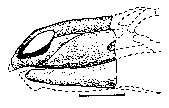 Chialingosaurus: C. kuani Young, 1959.
Chialingosaurus: C. kuani Young, 1959.
Range: Late Jurassic Oxfordian) of China.
Phylogeny: Kentrosaurinae :: (Chungkingosaurus + Stegosaurinae) + *.
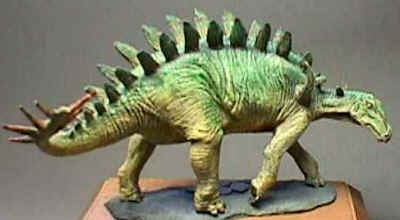 Chialingosaurus kuani Young, 1959
Chialingosaurus kuani Young, 1959
Horizon: Upper Shaximiao Formation, Sichuan, China
Age: Oxfordian
Place: north-east Pangea / east Laurasia
Remains: skull and skeletal fragments
Length: 4 metres
Weight: about 400 kg?
Characters: High narrow skull; slender limb-bones; front legs relatively long; femur, lesser trochanter triangular, with broad base; small, plate-like spines.
Image: model from チアリンゴサウルス.
Links: DD: CHIALINGOSAURUS; CHIALINGOSAURUS; Chialingosaurus. MAK990724, ATW031115.
Chungkingosaurus:
Range: Late Jurassic Oxfordian) of China.
Phylogeny: Kentrosaurinae ::: Stegosaurinae + *.
Chungkingosaurus laminaplacodus Dong, Zhou, & Zhang,1983
Horizon: Upper Shaximiao Formation, Sichuan Province,China
Age: Oxfordian
Place: north-east Pangea / east Laurasia
Remains: partial skeleton
Length: 3 to 4 metres
Weight: about 400 kg
Comments: The skull is high and narrow skull, and the sacrum and humerus primitive, all indicating a less-specialised form than Stegosaurus or Tuojungosaurus. There are large thick spine-like bony plates intermediate between spines and plates) and apparently four or five pairs of tail spines. May be transitional between Kentrosaurines and Stegosaurines. MAK990724.
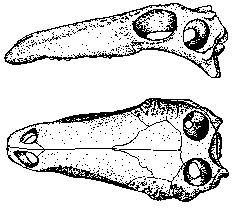 |
| Tuojiangosaurus skull in left lateral and dorsal views. |
Stegosaurinae: Monkonosaurus, Paranthodon, Yingshanosaurus
Range: Middle Jurassic to Late? Cretaceous
Phylogeny: Kentrosaurinae ::: Chungkingosaurus + * : Lexovisaurus + (Tuojiangosaurus + (Stegosaurus + Wuerhosaurus)).
Comments: The stegosaurines are sometimes divided into two tribes. The "Tribe Tuojiangosaurini" is a paraphyletic taxon; intermediate between the basal kentrosaurs which they resemble) and the "Tribe Stegosaurini," Generally, the Tuojiangosaurini retain the Kentrosaurine pattern of back and hip spines. The Stegosaurini are distinguished by large size, no spines on hips or shoulders, only two (or rarely 4) pairs of tail spines, relatively short forelimbs, small elongate head, large plates in life covered with skin and blood vessels. This tribe includes only two genera, Stegosaurus and Wuerhosaurus. MAK990724.
 Lexovisaurus:
Lexovisaurus:
Phylogeny: Stegosaurinae : (Tuojiangosaurus + (Stegosaurus + Wuerhosaurus)) + *.
Lexovisaurus durobrivensis (Hulke, 1887)
Horizon: Lower Oxford Clay and Kimmeridge Clay of England, Marnes d'Arences of France
Age: Middle Callovian to early Kimmeridgian
Place: European islands - middle Laurasia
Remains: skeletal elements, 3 partial postcrania,
Length: 5 to 6 metres
Weight: upto 1.5 tonnes
Comments: Superficially quite similar to Kentrosaurus, this early stegosaurine is a more closely related to Stegosaurus. It has large thin plates, and spines on the hip. In view of the time difference i is unlikely that the fragmentary Kimmeridgian material belongs to the same species as the Callovian material.
Lexovisaurus? vetustus (Huene, 1910)
Horizon: England
Age: Late Bathonian
Place: European islands - middle Laurasia
Remains: juvenile femur
Comments: tentatively assigned to the genus Lexovisaurus, although the material is too incomplete to be sure. The oldest known stegosaurid. MAK990724.
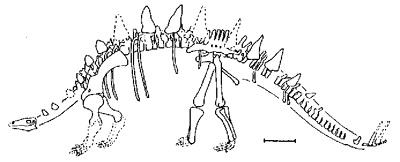 Tuojiangosaurus:
Tuojiangosaurus:
Range: Late Jurassic of China
Phylogeny: Stegosaurinae :: (Stegosaurus + Wuerhosaurus) + *.
Tuojiangosaurus multispinus Dong, Li, Zhou, & Zhang,1973
Horizon: Upper Shaximiao Formation, Sichuan, China
Age: Oxfordian
Place: north-east Pangea / east Laurasia
Remains: 2 partial skeletons
Length: 7 metres
Weight: 2 tonnes
Comments: The largest known Jurassic Asian stegosaur. The skull (left) is similiar to that of Stegosaurus. There 17 pairs of small spiny plates, as well as spines on the shoulders, hips, and tail. MAK990724.
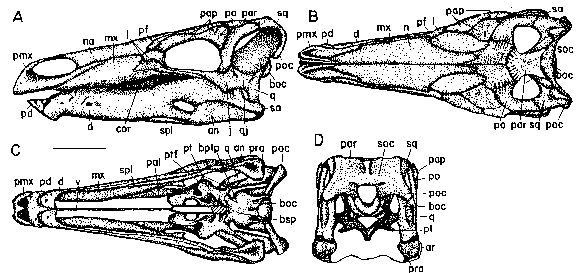 |
| Stegosaurus skull: an angular, ar articular, boc basioccipital, bptp basipterygoid process, bsp basisphenoid, cor coronoid, d dentary, j jugal, l lacrimal, mx maxilla, n nasal, pal palatine, pap palpebrals, par parietal, pd predentary, pf prefrontal, pmx premaxilla, po postorbital, poc paroccipital process, pra prearticular, pt pterygoid, ptf pterygoid flange, q quadrate, qj quadratojugal, sa suarngular, soc supraoccipital, spl splenial, sq squamosal, v vomer. |
Stegosaurus:
Range: Late Jurassic to Late? Cretaceous
Phylogeny: Stegosaurinae ::: Wuerhosaurus + *.
Note on Stegosaurus species: The controversial dinosaurologist Bob Bakker distinguishes between two types of Stegosaurus -- those with long legs and relatively smaller plates (Stegosaurus proper) and a more primitive form with shorter legs and larger plates (Diracodon). Dinogeorge however is critical of proposing a new stegosaur genus on this basis. Also, different sources (both in print and on the Web) give different lists of species; e.g. some are synonymised with others. It may be that some of these species are only subspecies or local variants. However, for the sake of completeness (and with the risk of further muddling the issue.... ) we have listed all the types here.
Stegosaurus armatus armatus Marsh,1887
Horizon: Upper Morrison formation, Colorado,Wyoming and Utah, USA
Age: early Tithonian
Place: west Laurasia
Remains: large number of skeletal elements
Length: 6 metres
Weight: 2 tonnes
Comments: The type species of the genus. Has longer legs and relatively smaller plates than S. stenops; 2 pairs of tail spines
Stegosaurus armatus ungulatus Marsh, 1879
Horizon: Upper Morrison formation, Wyoming and Utah, USA
Age: early Tithonian
Place: west Laurasia
Remains: large number of skeletal elements
Length: upto 9 metres
Weight: 5 tonnes
Comments: Along with Dacentrurus armatus, this is the largest known stegosaurid. The limbs are long and slender. It has four pairs of tail spines, and the middle part of the tail bears paired spine-plates. The sacral centra are broad and rounded and lack a ventral keel. This may be variant of S. armatus, rather than a distinct species.
Stegosaurus stenops stenops Marsh, 1877
Horizon: Morrison formation, Colorado,Wyoming and Utah, USA
Age: Kimmeridgian to early Tithonian
Place: west Laurasia
Remains: large amount of skeletal elements
Length: 6 to 7 metres
Weight: 2 tonnes
Comments: S. stenops has very large plates and relatively shorter legs. The sacral centra have a ventral keel. There are two pairs of tail spines. Bob Bakker sugests this species should be relocated under its original genus Diracodon
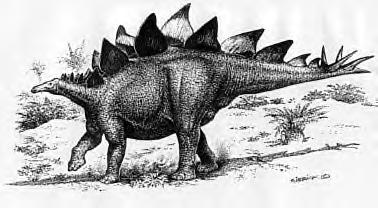 Stegosaurus stenops laticeps Marsh, 1881
Stegosaurus stenops laticeps Marsh, 1881
Horizon: Morrison formation, Wyoming , USA
Age: late Kimmeridgian
Place: west Laurasia
Remains: large number of skeletal elements
Length: 6 metres
Weight: 2 tonnes
Comments: This form may be same as S. stenops
Stegosaurus longispinus Gilmore,1914
Horizon: Morrison formation of Utah, USA
Age: Early Tithonian
Place: west Laurasia
Remains: fragmentary skeleton
Length: 7 metres
Weight: 2 tonnes
Comments: This species is distinguished by two pairs of very elongate (a meter in length) tail spines. MAK990724.
Links: DinoData Dinosaurs S113 STEGOSAURUS; Stegosaurus - Dinosaur - Enchanted Learning Software; Stegosaurus (and you thought we were demented!); Home Page Student site, but nicely done); BBC - Walking with Dinosaurs - Fact Files; Summing Up Stegosaurus, 1914; Stegosaurus Danish). ATW030901.
Wuerhosaurus:
Range: Early Cretaceous to Middle Cretaceous of China
Phylogeny: Stegosaurinae : Stegosaurus + *.
Characters: body relatively and short and wider at hip than other stegosaurids; proximal caudal neural spines very long;11 dorsal vertebrae; long, large, low, rounded back plates; back plates alternating, not paired; sacrum with almost solid dorsal plate; thagomizer with 4 spikes; forelimbs very short; ischium distal end dorsoventrally expanded.
Wuerhosaurus homheni Dong,1973
Horizon: Lianmuging Formation, Xinjiang Uygur Zizhiqu,China
Age: Valanginian/Hauterivian/Barremian/Aptian/Albian
Place: east Laurasia
Remains: partial skeletons
Length: 6 to 8 metres
Weight: 2 to 3 tonnes
Comments: Among the last of the stegosaurs, Wuerhosaurus is closely related to Stegosaurus, with a similiar arrangement of plates and spines. It differs in that Wuerhosaurus plates are long and low, unlike the tall lozenge-shaped plates of Stegosaurus.
Wuerhosaurus ordosensis Dong 1993
Horizon: Lianmuging Formation, Xinjiang Uygur Zizhiqu,China
Age: ?Barremian
Place: east Laurasia
Remains: partial skeletons
Length: 4 metres
Weight: about 500 kg
Comments: A small species of this genus
Links: Wuerhosaurus Fact Sheet - EnchantedLearning.com; WUERHOSAURUS; DinoData Dinosaurs W008 WUERHOSAURUS; Dinosaur museum (Chinese); ?????? ??? (Japanese).
 The photograph shows the side and top-bottom view of the large plates on the back of the Stegosaurus. Originally thought to have been a form of armour-plating, the plates of advanced stegosaurs were, as can be seen here, actually quite thin and full of holes for the accomodation of blood vessels. For all large animals heat disipation is a big problem (that is why African elephants have such large ears for example), and the stegosaur plates clearly served this purpose. The plates tend to be small and poorly developed (or even absent) in primitive stegosaurids, but more developed in more advanced forms, indicating that they conferred an adaptive advantage. The advantage may have been related to thermoregulation.
The photograph shows the side and top-bottom view of the large plates on the back of the Stegosaurus. Originally thought to have been a form of armour-plating, the plates of advanced stegosaurs were, as can be seen here, actually quite thin and full of holes for the accomodation of blood vessels. For all large animals heat disipation is a big problem (that is why African elephants have such large ears for example), and the stegosaur plates clearly served this purpose. The plates tend to be small and poorly developed (or even absent) in primitive stegosaurids, but more developed in more advanced forms, indicating that they conferred an adaptive advantage. The advantage may have been related to thermoregulation.



 Kentrosaurus
Kentrosaurus Chialingosaurus
Chialingosaurus

 Lexovisaurus
Lexovisaurus

